Bookmark/Search this post with
- A Testimonial -
Avian Supplements Tested
Surprising Results…
By Mark Heron
Because I am an engineer, I though it might be interesting to test avian supplement products using a technique know as a GC/MS – Gas Chromatograph and Mass Spectrometer. The results are outlined along with the story of the Gouldians we purchased from a breeder who we thought was experienced.
One of the largest mistakes that I made was agreeing to forward a check for payment on two pairs of Lady Gouldian Finches in advance of an on-site inspection. This particular breeder had received $250.00 for each pair and had already cashed the check. What I found when I arrived at his home was a carport attached to a mobile home that had been poorly converted into a bird room. The atmosphere reeked of mold and mildew. I found approximately 20 - 12" length x 12" high x 8" wide cages with nest boxes in each cage. To one side of the room was a small flight cage with a handful of Gouldian youngsters in it. There was also approximately 10 pair of Bengalese finches.
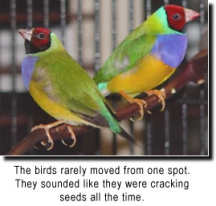 Looking back, I know now that all the Goulds were suffering from respiratory mite infections. The expected "clicking" noise while breathing was evident, but I did not know at the time that this was a problem. The Goulds were fed millet and a low-cost diet of finch mix. Calcium supplements were also provided, but one could clearly see that the "grit" had not been changed in quite a while as it was caked and full of fecal material. There was an abundance of moths within the room.
Looking back, I know now that all the Goulds were suffering from respiratory mite infections. The expected "clicking" noise while breathing was evident, but I did not know at the time that this was a problem. The Goulds were fed millet and a low-cost diet of finch mix. Calcium supplements were also provided, but one could clearly see that the "grit" had not been changed in quite a while as it was caked and full of fecal material. There was an abundance of moths within the room.
Condition deteriorated
At least one week passed and the condition of the Goulds continued to deteriorate. Luckily, I had 24 hour access to a Diplomat of Avian Medicine who I worked with for years, within 60 miles of my home. I took both pair of Gouldians to her late on a Sunday afternoon. The condition of both pair had deteriorated to the point that their small cages were quickly placed in a temperature controlled incubator that also had an oxygen feed attached. We began an aggressive oral treatment of Ivermectin to treat the air sac mites. We did not honestly expect either pair to "make it" as the daily handling of the Gouldians would no doubt add to the stress being placed on their already taxed immune systems. Further test results indicated that the pairs also had a concomitant yeast infection as well as Enterobacter bacteria. The odds were not looking good as two additional medications would be necessary to properly address all of the issues. Clearly, these Gouldians were literally on their last legs, panting for air, reticent to eat.
Weathered the storm
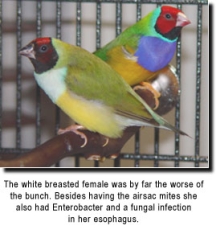 Almost 14 days later, the veterinarian called. All the birds had weathered the storm and had resumed eating activities. Further testing revealed that all original health problems were resolved. My wife and I felt blessed. During the time of our Gouldian's hospitalization, we were busy arranging for new housing here at home. Each pair currently resides in a cage that is 4' wide, 2' deep, and about 30" high. The cages were placed in an eastern exposure area, a quiet part of our home. We had upgraded their finch mix and ordered Dr Marshall’s vitamin & mineral supplements, Ioford and Dufoplus.
Almost 14 days later, the veterinarian called. All the birds had weathered the storm and had resumed eating activities. Further testing revealed that all original health problems were resolved. My wife and I felt blessed. During the time of our Gouldian's hospitalization, we were busy arranging for new housing here at home. Each pair currently resides in a cage that is 4' wide, 2' deep, and about 30" high. The cages were placed in an eastern exposure area, a quiet part of our home. We had upgraded their finch mix and ordered Dr Marshall’s vitamin & mineral supplements, Ioford and Dufoplus.
Additions of soft food and fresh food were prepared daily. Egg food was also eagerly accepted during their transition to our home. The goal was to re-ignite the fire within these beautiful birds from heaven and help them regain their normal weight as quickly as possible.
After 8 weeks the birds were healthy enough to begin their molt. Our little rainbows of joy seemed to be becoming a bit more sluggish as this process intensified. Not too long after, the molt came to a halt, greeted by a thousand tiny new pin feathers. We firmly believe that the improvement in diet, water (filtered for Chlorine as well as parasites), and more spacious living conditions contributed to the amazing recovery of these Goulds.
Skeptical of Supplements
Initially, we had been skeptical of using supplements other than those provided in the natural foods. Research into finch nutrition quickly revealed that even the best attempt to mimic nature's diet was still woefully inadequate. I had tried a number of nutritional supplements in the past on our other larger parrots. These products proved to be of little or no value.
Supplements failed the test
Because I am an engineer, I thought it might be interesting to test avian supplements using a technique known as a gas spectrometer. This device can be used to isolate any and all known compounds in a substance. One of the more common uses of Gas Spectroscopy is to help patients in the emergency room that appear to be suffering a chemical toxicity. Although I will not state which brands were evaluated, the results were interesting to say the least. Many of the off the shelf products did not contain their stated ingredients and some of the ingredients such as EDTA is not approved for human consumption, so I can’t imagine their effect on birds. The only one that truly contained the listed ingredients in the quantities specified were the ones developed by Dr. Marshall. From an engineer’s standpoint, a Gas Spectrometer/Chromatograph is THE defining method by which supplements need to be evaluated. I was surprised that the supplements failed the test to contain their labeled ingredients. I was relieved to learn that at least one, Dr. Rob Marshall, values his integrity and has furthered the study of proper nutrition in caged birds. Dr. Marshall truly is putting his money where his mouth is. I have the proof to support it!
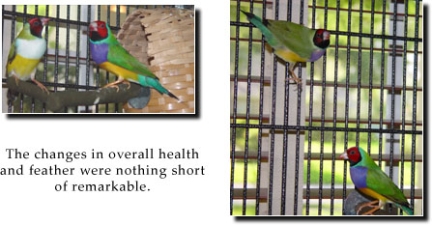
I continue to use Dr. Marshall's products exclusively. The changes in overall health and feather were nothing short of remarkable. I would urge anyone who may have had less than positive experience with other supplements to try again – this time with a quality product.
Cost for treatment
We found that the cost of treating a sick bird can be very expensive. The costs to treat our four exceeded $600.00. However, our desire to provide the best care available to attempt to save them from imminent death has been returned 1000 fold. Our Gouldians are now provided with fresh water twice daily, disinfecting the water feeders each time using Dr. Marshall's sanitizing KD powder. Fresh greens and veggies (grasses, sprouted seeds etc) are provided early each morning. Around 2:00 pm fresh soft foods and various fresh fruits are provided as an afternoon treat in addition to their staple seed mix. It is a routine that has become a pleasure not a chore. Cages and perches are sanitized at LEAST once weekly. The results of good hygiene have resulted in gorgeous plumage, vibrant color, and a whole lot of noise and activity throughout the day. My wife and I have always believed that we are stewards of the animals that share our lives, and no expense is too small to ensure the comfort and health of our birds. I urge Gouldian lovers everywhere to stop and remember what precious little gems these finches are. That combined with the fact that the Gouldians in the wild population continue to decrease should encourage one to do all that is within his/her means to extend the utmost courtesy and respect toward these beautiful animals.
Our Gouldians help us spend quality time together. I would also suggest that if more people who are involved with aviculture would extend a kind hand to novices such as ourselves, that the current concern over the future state of aviculture in America may divert some of our young people more toward the wonderful animals that surround us. When one experiences the behavior of a true Gouldian pair, the essence of true love is clearly revealed. It warms my heart to see these Goulds be so tender to each other. Examples of kindness and love exist in nature.
Laraine, from the warmest most thankful place in our hearts, my wife and I give thanks daily that experienced Gouldian breeders such as yourself give so much of their time, experience, and self to help
those of us who are otherwise beginners. We thank you for all the help you have provided, and, more importantly, for helping direct us down a path of truth and love.
Mark Heron - Florida
 Do you have a question that you have not found an answer for throughout this website or in my FAQ? Use this link to send your question directly to me. Be as specific as possible about the symptom or behavior in question...
Do you have a question that you have not found an answer for throughout this website or in my FAQ? Use this link to send your question directly to me. Be as specific as possible about the symptom or behavior in question...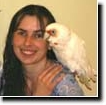 Tailai O’Brien is a Parrot Behavior Consultant who has worked along side Dr. Marshall and has developed special regimes for successful bird training and behavioral development. Fill out her Questionnaire so that she may help you with your parrot’s bad behavior.
Tailai O’Brien is a Parrot Behavior Consultant who has worked along side Dr. Marshall and has developed special regimes for successful bird training and behavioral development. Fill out her Questionnaire so that she may help you with your parrot’s bad behavior.

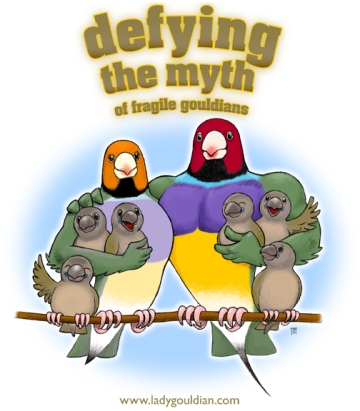




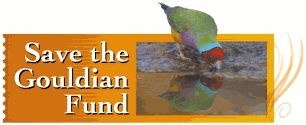
 Looking back, I know now that all the Goulds were suffering from respiratory mite infections. The expected "clicking" noise while breathing was evident, but I did not know at the time that this was a problem. The Goulds were fed millet and a low-cost diet of finch mix. Calcium supplements were also provided, but one could clearly see that the "grit" had not been changed in quite a while as it was caked and full of fecal material. There was an abundance of moths within the room.
Looking back, I know now that all the Goulds were suffering from respiratory mite infections. The expected "clicking" noise while breathing was evident, but I did not know at the time that this was a problem. The Goulds were fed millet and a low-cost diet of finch mix. Calcium supplements were also provided, but one could clearly see that the "grit" had not been changed in quite a while as it was caked and full of fecal material. There was an abundance of moths within the room.  Almost 14 days later, the veterinarian called. All the birds had weathered the storm and had resumed eating activities. Further testing revealed that all original health problems were resolved. My wife and I felt blessed. During the time of our Gouldian's hospitalization, we were busy arranging for new housing here at home. Each pair currently resides in a cage that is 4' wide, 2' deep, and about 30" high. The cages were placed in an eastern exposure area, a quiet part of our home. We had upgraded their finch mix and ordered Dr Marshall’s vitamin & mineral supplements, Ioford and Dufoplus.
Almost 14 days later, the veterinarian called. All the birds had weathered the storm and had resumed eating activities. Further testing revealed that all original health problems were resolved. My wife and I felt blessed. During the time of our Gouldian's hospitalization, we were busy arranging for new housing here at home. Each pair currently resides in a cage that is 4' wide, 2' deep, and about 30" high. The cages were placed in an eastern exposure area, a quiet part of our home. We had upgraded their finch mix and ordered Dr Marshall’s vitamin & mineral supplements, Ioford and Dufoplus. 